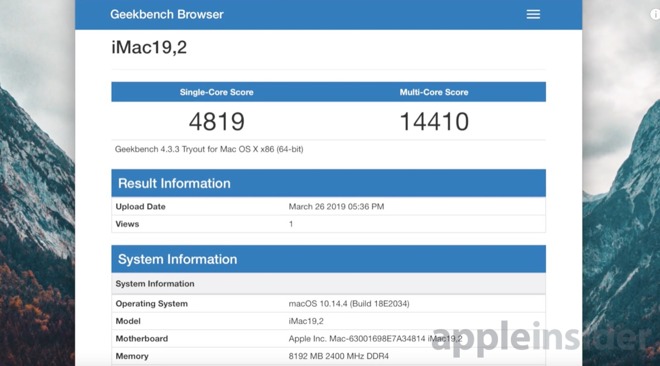

Think of the possibilities for iOS developers exploring augmented reality (AR) in these machines.Įverything else in the iMac Pro /wg5R3gURoP These include a new Camera Image Signal Processor and 30-bit color. You can explore lots more technical details concerning these new iMacs here, but Apple also hinted at a range of other interesting enhancements when it discussed the new Mac in June. The performance data revealed by Geekbench suggests the new iMacs will eclipse even the very best Surface Studio configurations, as you might expect from machines Apple has already promised will exceed 22 Teraflops of GPU performance. Apple has previously told us it developed a new thermal architecture for the system, delivering up to 80 percent “more cooling capacity.” MacRumors spoke with Geekbench founder John Poole, who suspects Apple may also have down-clocked chip speeds in order to squeeze them into the Mac form factor. It’s possible the new iMac lineup could be announced as soon as this month.We can’t be certain these are the benchmarks for the new iMac Pros, but all the main Apple rumor websites seem to think they might be. During the WWDC keynote, however, Apple did tease that it still has new Intel Macs in the pipeline, despite the looming transition to Apple Silicon. Rumors had suggested Apple would debut its new iMac at WWDC, but that didn’t ultimately happen. The 10th generation Intel Core i9-10910 seen here will likely be saved for the higher-end models. This is likely to be a “desktop variant of the Radeon Pro 5300M that AMD announced last year” with a maximum clock speed of 1,650 MHz for the Radeon Pro 5300 and 4GB of onboard memory.Ĭurrently, Apple’s 27-inch iMac is available in several different configurations, including 8th and 9th generation Intel Core processors. The Geekbench test results also indicate that the forthcoming iMac will feature the yet-to-be-announced AMD Radeon Pro 5300 graphics card. Furthermore, slapping a locked processor into the iMac would prevent users from overclocking. It would also be more profitable for Apple to use a Core i9-10910 instead of a downclocked Core i9-10900K in its upcoming iMac. That wouold make the unannounced CPU cheaper to produce. The Core i9-10910 is probably using recycled silicon that doesn’t meet the requirements for the Core i9-10900K. Why exactly would Apple would put in a custom order? It’s hard to say for sure. “Currently, Intel doesn’t have a true Core i9 95W processor in its Comet Lake-S portfolio and that would explain why the chipmaker could have cooked up a special part for Apple,” the report explains.

Tom’s Hardware speculates that the Apple-exclusive version of the chip is a 95W processor, putting it in between Intel’s other 65W and 125W options. This suggests that it’s a higher clocked version of the Core i9-10900 with a 28.6% higher base clock. The Geekbench results show that the Core i9-10910 runs with a 3.6 GHz base clock and 4.7 GHz boost clock. Ultimately, the listed clock speeds are what differentiates the Core i9-10910 from its siblings. In this case, the processor sports 10 CPU cores, 20 threads and 20MB of 元 cache. This follows the mainstream of the 10th Generation Comet Lake-S processors in April.īeing a member of the Core i9 family, the CPU comes with the same base specifications as the other variants. Tom’s Hardware explains that the 10-core Intel Core i9-10910 is likely a custom-tailored chip from Intel that will be exclusive to Apple. The benchmark results were first shared by rogame on Twitter and spotted by Tom’s Hardware as well. Ahead of the official release, new benchmarks have surfaced that allegedly show a new iMac powered by Intel’s Core i9-10910 CPU with the AMD Radeon Pro 5300 GPU. Various rumors have suggested that Apple has a new family of iMac models on the way sooner rather than later.


 0 kommentar(er)
0 kommentar(er)
